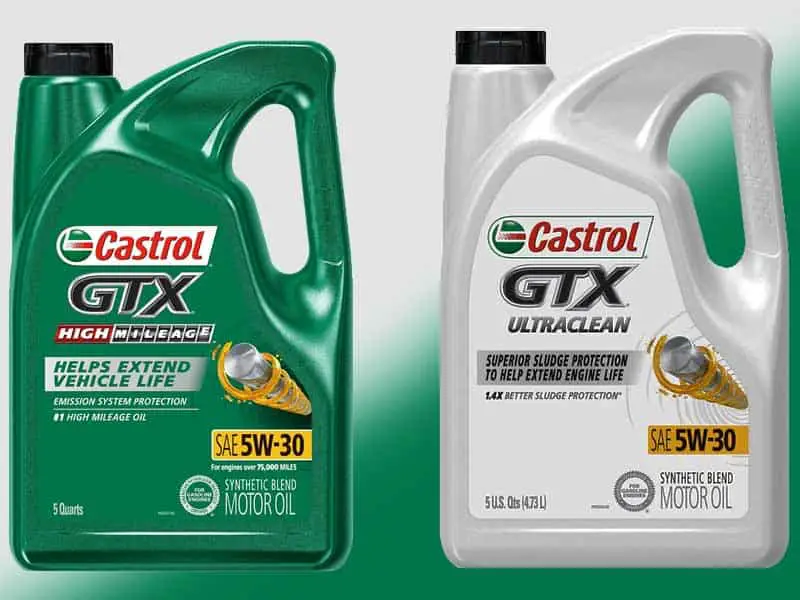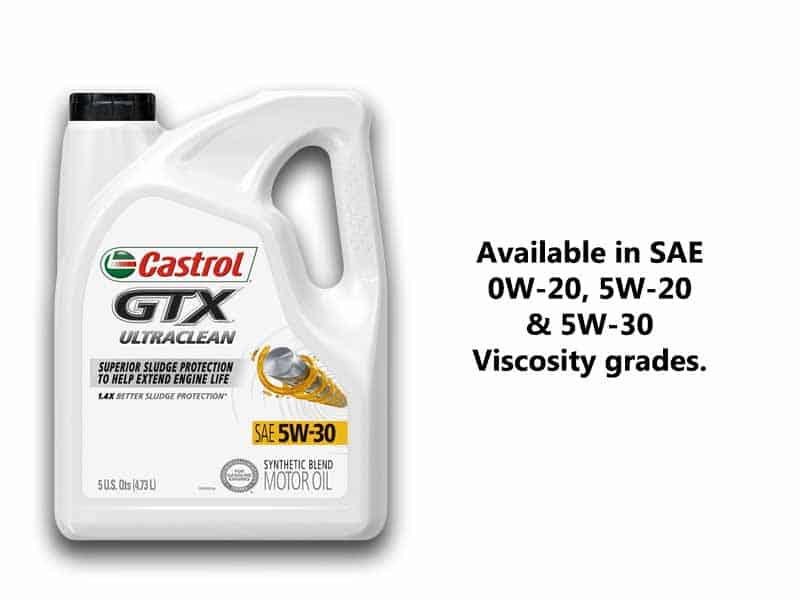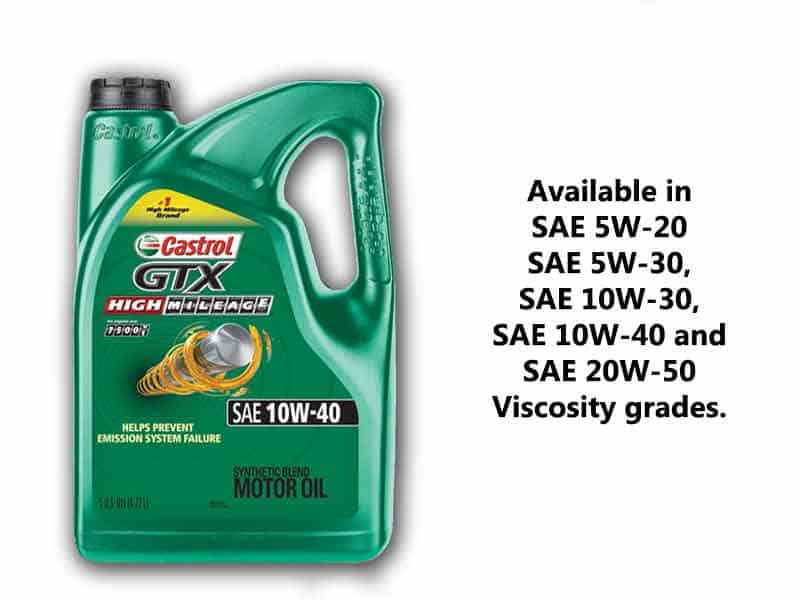GTX Ultraclean, as the name implies, excels at cleaning and preventing. With its Double-Action formula, it is recommended for use in modern gasoline-powered vehicles, SUVs, passenger cars, high-performance turbocharged engines, and light-duty petrol and diesel engines.
Castrol GTX High-Mileage, on the other hand, is renowned for its ability to extend engine life and prevent emission system failure, with its Phosphorus Replacement Technology, on vehicles accumulating over 75000 miles. It contains a special sludge buster to remove ugly sludge deposits, varnish, and carbon buildup, as well as detergents and anti-wear compounds to keep your engine running like new.

Table of Contents
Side By Side Comparison:
| Specifications | Castrol GTX Ultra Clean | Castrol GTX High Mileage |
| Oil Type | Synthetic blend | Synthetic blend |
| Engine Type | Gasoline | Gasoline |
| Available Viscosity Grades | 0W-20, 5W-20, 5W-30 | 5W-20, 5W-30, 10W-30, 10W-40, 20W-50. |
| ILSAC | Meets or exceeds ILSAC GF-6 | Meets or exceeds ILSAC GF-6 |
| API | Meets or exceeds API SP, SN PLUS, and SN | Meets or exceeds API SP, SN PLUS, and SN. |
| GM approval | Does not have GM approval; | Does not have GM approval |
| Ford approval | Meets Ford WSS-M2C947-B1 and Ford WSS-M2C962-A1 | Meets Ford WSS-M2C945-B1 and Ford WSS-M2C960-A. |
| ACEA | Not rated for European vehicles | Not rated for European vehicles |
| Additives | Anti-wear additives, proprietary sludge buster. | Seal conditioners, advanced anti-wear additives, dispersants |
Viscosity Comparison:
Castrol GTX Ultraclean is available in SAE 0W-20, 5W-20, and 5W-30 while Castrol GTX High mileage features 5W-20 5W-30 10W-30 10W-40 20W-50 viscosities. The lower the viscosity of engine oil in low temperatures, the easier it flows, and the higher the viscosity when hot, the thicker the oil is to protect your engine against friction.

Oil carrying viscosity grades of SAE 5W-20, 0W-20 are recommended for use in modern gasoline-powered vehicles, SUVs, passenger cars. In contrast, SAE 5w-30 is recommended for use in high-performance turbocharged engines and light-duty petrol and diesel engines.

SAE 10W-30 is recommended for use in vehicles carrying heavier loads or luggage, SAE 10W-40 is suitable for high mileage engines to provide better lubrication for older engine components, and SAE 20W-50 is ideal for use in vehicles involved in high-stress activities like pulling trailers and hauling and works well in both gasoline and diesel engines, as well as aviation vehicles.
Oil Type & Additives Comparison
Both Castrol GTX oils are synthetic blends that use Group III oils as their base stock. Being synthetic blends, they give your engine a mix of synthetic and conventional oil benefits (a little of both worlds).
Speaking of additives, both oils contain a range of additives to protect and fight against sludge, cure leaking seals, prevent wear and tear of the engine and improve catalytic converter performance.
Ultraclean is packed with proprietary sludge buster to eradicate nasty sludge deposits, varnish and carbon build-up, detergents, and anti-wear additives to protect against friction and form a film over moving parts of the engine.
High-Mileage, along with Phosphorus replacement technology, is full of seal conditioners to rejuvenate cracked head gaskets and leaking seals, a unique blend of advanced anti-wear additives, cleaning agents (detergents) to pick up the dirt and grime, and dispersants to prevent soot particles from accumulating on the critical parts of the engine.
Engine Performance:
Catalytic Converter performance:
Catalytic converter failure, though usually invisible, can cause irreparable damage to your engine. It can occur for several reasons:
- Phosphorous poisoning: When engine oil burns off, it gives off vapor that gets carried through into your vehicle’s emission system. The vapor contains by-products like phosphorus, a well-known poison for the catalytic convertor. Over time, phosphorus accumulates in the design, causing damage to the catalytic converter.
- Incomplete combustion and Engine misfiring: If fuel remains unburned outside the combustion chamber, it will go into the exhaust system and ignite when it reaches the catalytic converter, a process known as ‘engine misfiring.’ In turn, this creates intense heat, causing a catalytic converter to overheat, leading to “convertor meltdown,” which damages the converter internally.
- Road Damage: The honeycomb pattern inside the catalytic converter is made of fragile material and covered by an insulating mat that offers protection against damage. Road debris, broken hangers, or off-road driving strikes the convertor, resulting in “catalyst fracture.” The broken pieces chip away from the converter and interrupt the flow of the engine oil. This interruption increases the backpressure in the exhaust system, leading to heat build-up and, ultimately, damage to the catalytic convertor. Once the ceramic catalyst is fractured, the broken pieces become loose, rattle around, and break up into smaller pieces.
Castrol GTX UltraClean, with its exceptional cleaning properties, cleans and prevents the accumulation of carbon deposits on the catalytic converter, thus keeping it clean and healthy.
The Castrol GTX High-mileage with active phosphorus replacement technology contributes to a significant reduction in phosphorus levels in the motor oils, which in turn extends engine life and enhances the catalytic convertor’s efficiency by blocking out harmful pollutants.
Also, as both oils carry ILSAC GF-6 approval, they comply with recent emission regulations and effectively reduce harmful gases coming out of the car exhaust pipe.
Reduction of Sludge built-up:
Sludge and carbon deposits can block engine oilways, increase oil consumption and reduce overall engine performance.
Castrol GTX Ultraclean, with its double action formula, cleans away and prevents the formation of new sludge on engine components. According to API SN Sequence VG Sludge Test, this oil keeps your engine 50% cleaner than stringent industry standards and provides 1.4X better sludge protection to the engine as proven by Sequence VH Sludge Test.
Castrol GTX’s high mileage with superior dispersants and a blend of calcium and magnesium compounds wipe the sludge away from the engine’s metal parts like piston rings, fuel injectors, and valves. Being a high-mileage oil, it also contains seal conditioners that moisturize worn-out rubber seals and puff up the leaking seals of aging engines.
Protection against wear:
Both oils contains a blend of boron, molybdenum, phosphorus, and zinc compounds, that act as anti-wear additives and provide unsurpassed protection to the critical components of the engine from regular wear and tear caused by friction, hot weather, and harsh driving conditions.
The by-products of the combustion process like sulphuric acid corrode the metal of the pistons, cylinders. TBN number measures the alkalinity of a lubricant. The TBN number of Castrol GTX Ultraclean and Castrol GTX High-mileage is 8.66 and 8.96, respectively.
With a high TBN number, Castrol GTX High mileage oil is more effective than the other at neutralizing acidic materials, preventing corrosion, and extending engine life.
Conclusion:
In a nutshell, both oils are top-notch motor oils that provide optimal performance and ensure that you drive your vehicle with confidence. We have provided you with a comprehensive analysis of these two high-quality motor oils so you can make an informed buying decision and choose the one best suited to your engine’s needs.
Castrol GTX Ultraclean offers unsurpassed protection against sludge build-up (as proven by various industry tests), with its double action formula and lengthen the lifespan of your engine. Castrol GTX High Mileage with its Phosphorus replacement technology boosts catalytic converter performance and rejuvenate cracked and leaky seals with its unique blend of seal conditioners.